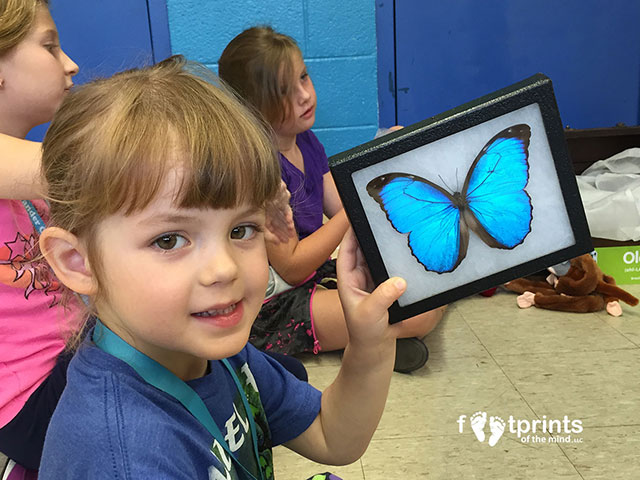The Blue Morpho butterfly lives in rainforests in Central and South America in countries such as Mexico, Costa Rica, Venezuela, and Brazil. Blue Morpho butterflies mostly live the in the forest canopy level however, they have been seen on forest floors in clearings.
Blue Morpho butterflies are iridescent blue but have brown undersides. They are active during the day (diurnally active) and sleep at night. They close their wings when they sleep so only the brown underside shows. This makes them less visible to predators.
Is the Blue Morpho butterfly poisonous?
YES! It will eat poisonous foods in the caterpillar stage to make itself poisonous. If bothered, it secretes a substance that smells like spoiled butter and can irritate human skin.
What’s a Frugivore?
As an adult butterfly it uses its proboscis, which is like a straw, to suck juice from rotting fruit. They rarely drink nectar from flowers and are considered fruit feeders therefor they are considered frugivores!
Blue Morpho butterflies have a short life span and live for about a month. Entomologists supply us with specimens like the one pictured. The specimens we have are not museum quality. In addition, some specimens are considered damaged, therefor collectors won’t pay top dollar for them. However, we can’t tell the difference and in our eyes, they are stunning!
Students love our Blue Morpho Butterfly. We provide a great educational hands-on experience of these magnificent butterflies which is always better than just viewing a photo.
If you are a teacher looking for a classroom adventure, bring our Blue Morpho butterfly to your classroom by visiting our educational partnership page. Make a note that Brazil would be a country you would like your students to “visit”, or fill out our contact page to reach out directly.
Purchase our Brazil kit that has the Blue Morpho butterfly craft project.
For a PreK-4th grade children’s book that describes all the stages of the butterfly life cycle, read Handle With Care*, “Some farms grow vegetables or grains, and some raise cows, sheep, chickens, or pigs. But have you ever heard of a butterfly farm? How do you raise a butterfly? On a farm in Costa Rica, workers care for these delicate, winged creatures as they change from eggs to caterpillars to pupae.”
*We make it easy to support geography education with Footprints of the Mind. At no added cost to you, every time you make a purchase from our website, Footprints of the Mind receives a small commission. Thank you for helping us continue our mission of raising globally competent children.



